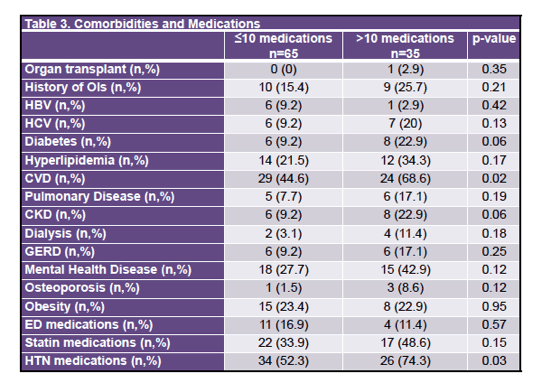 |
 |
 |
| |
[35% Taking 12 Comedications !] - Polypharmacy in HIV+ 50 or Older Linked to Lower CD4s, Higher CVD Rate - Evaluating the Effect of Polypharmacy on Outcomes in HIV-Infected Patients Age 50 and Older
|
| |
| |
IDWeek 2016, October 26-30, 2016, New Orleans
----------------
from Jules: this study was conducted at Northwestern ID Center, 53-62% were caucasians, of 100 patients studied 35% were taking an average of 12 comedications + 2 ART/HIV medications at average age of 61 (56-66). Take a look at Table 3 where you will see high rates of comorbidities for both groups, those taking more or less than 10 comedications, but much higher for those taking 10 or more comedications - for these patients 23% have diabetes, 20% HCV, 34% hyperlipidemia, 68% cardiovascular disease (CVD), 17% pulmonary disease, 23% kidney disease, 11% on dialysis !, 42% with mental health disease ! , 48% taking statins, and 74% on hypertension medication - WOW ! Do you really think this is not an EXPLOSIVE situation, something has to give ! This is not sustainable.
Although not statistically significant adherence is lower in patients taking 10 or more co-medications 64% vs 48%, but over time in my opinion & for more marginal patients adherence will suffer with polypharmacy particularly with 10 or more comoedications, the median was 12 & 14 when counting ARTs. The average age is only 61 for those on 10 or more co-medications, so my guess is as these patients age adherence will suffer and although the overall adherence difference was not statistically significant for some portion of these patients who might be suffering more with cognitive or neurologic impairment & frailty adherence might be significantly worse.
---------------------
Mark Mascolini
HIV patients 50 or older who took more than 10 medications had a lower CD4 count, higher cardiovascular disease (CVD) rate, more adverse drug effects, and more drug-drug interactions than older people taking fewer medications [1]. A lower proportion taking more than 10 drugs tended to have an undetectable HIV load in this 100-person comparison.
As HIV populations age, they will acquire more comorbidities and take more medications that may cause side effects, threaten drug-drug interactions, and challenge adherence. This retrospective analysis involved HIV-positive people 50 or older seen at a Chicago infectious disease center between June 2013 and January 2014. Researchers divided them into 65 people taking 10 or fewer medications and 35 taking more than 10.
Median age stood at 61 in the group taking more than 10 medications and at 57 in the comparison group (P = 0.04). The more heavily medicated group took a median of 12 drugs not including antiretrovirals, compared with 4 drugs in the less medicated group (P < 0.01). Respective medians including antiretrovirals were 14 and 6 (P < 0.01). People taking more than 10 medications had a lower median CD4 count (351 versus 561, P = 0.01) and a marginally longer median HIV infection duration (19.5 versus 15 years, P = 0.11).
Compared with people taking 10 or fewer medications, those taking more had a higher prevalence of cardiovascular disease (69% versus 45%, P = 0.02), diabetes (23% versus 9%, P = 0.06), and chronic kidney disease (23% versus 9%, P = 0.06). A higher proportion of the more heavily medicated group took antihypertensives (74% versus 52%, P = 0.03).
A marginally lower proportion of people taking more than 10 medications had an undetectable viral load (68% versus 84%, P = 0.07). Adherence did not differ significantly between groups, but adherence remained undocumented in about one quarter of participants.
The group taking more than 10 drugs included a significantly lower proportion with glucose at goal level (58% versus 80%, P = 0.04), a significantly higher proportion with medications on Beer's list* (71% versus 42%, P < 0.01), a significantly higher proportion with adverse drug effects (46% versus 26%, P = 0.047), and a significantly higher number of drug-drug interactions (7 versus 1, P < 0.01). Thirty-three of 35 people taking more than 10 drugs had drug interactions, compared with 44 of 65 taking fewer drugs (94% versus 68%, P < 0.01).
*Potentially inappropriate medications for elderly people.
Reference
1. Wilcox ML, Cottreau J, Mancuso T, et al. Evaluating the effect of polypharmacy on outcomes in HIV-infected patients age 50 and older. IDWeek 2016, October 26-30, 2016, New Orleans. Abstract 1496.
--------------------------
Evaluating the Effect of Polypharmacy on Outcomes in HIV-Infected Patients Age 50 and Older
Michael L. Wilcox, PharmD1;Jessica Cottreau, PharmD1,2;Taylor Mancuso, PharmD3;Frank J. Palella, Jr., MD4;Michael Postelnick, BS, RPh1; Milena M. McLaughlin, PharmD, MSc1,31Northwestern Memorial Hospital, Chicago, IL, USA; 2Rosalind Franklin University of Medicine and Science, North Chicago, IL, USA; 3Midwestern University Chicago College of Pharmacy, Downers Grove, IL, USA;4Division of Infectious Diseases, Northwestern University Feinberg School of Medicine, Chicago, IL, USA



|
| |
|
 |
 |
|
|